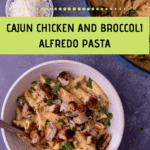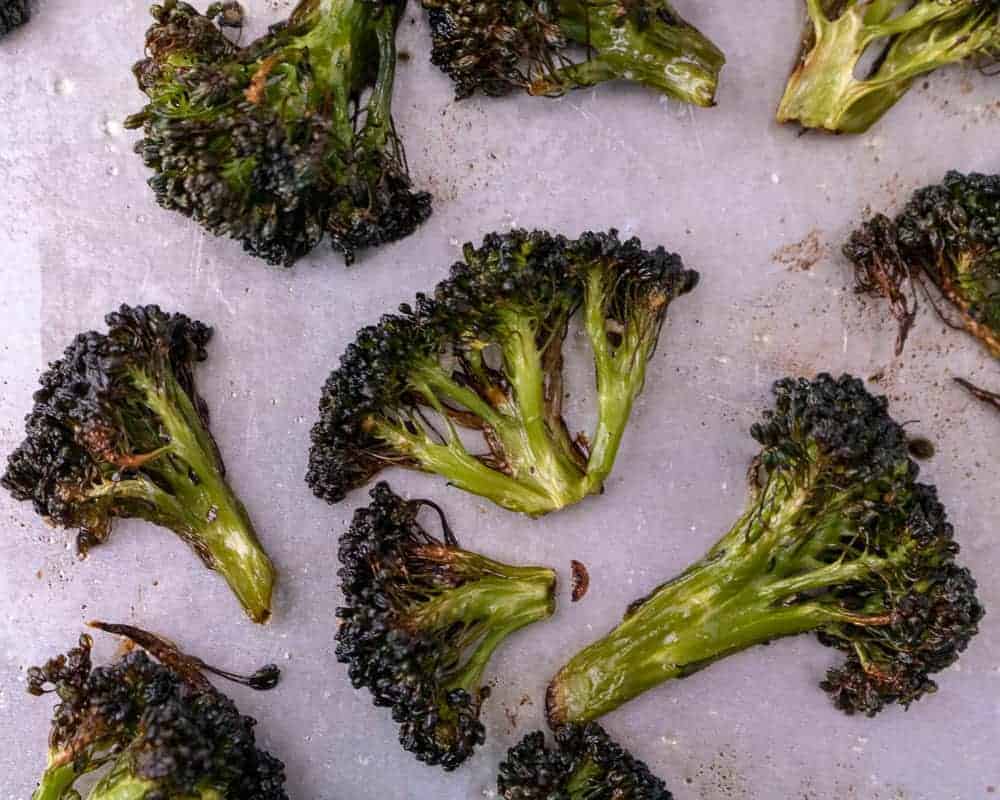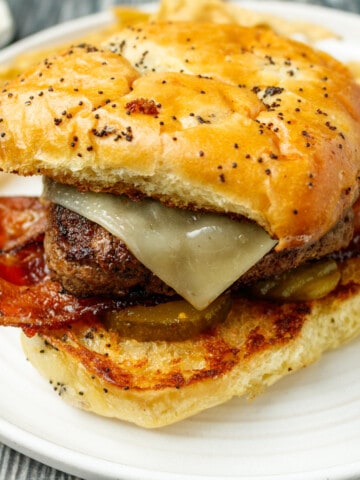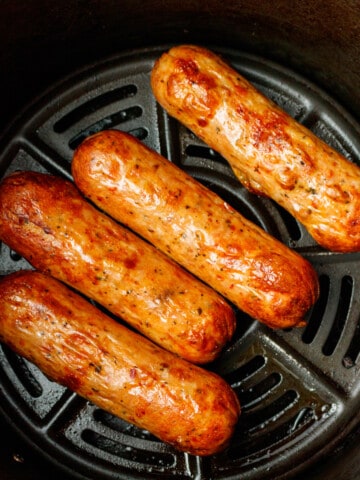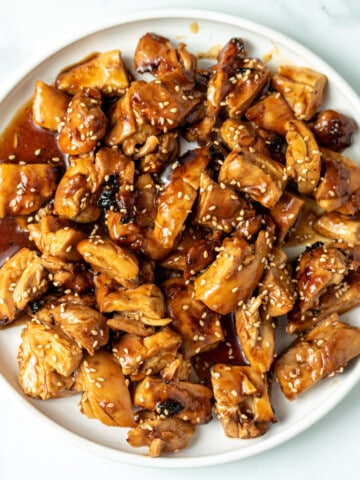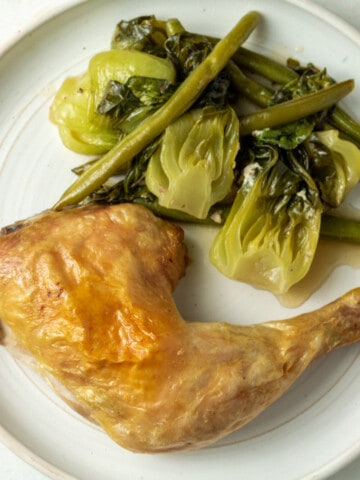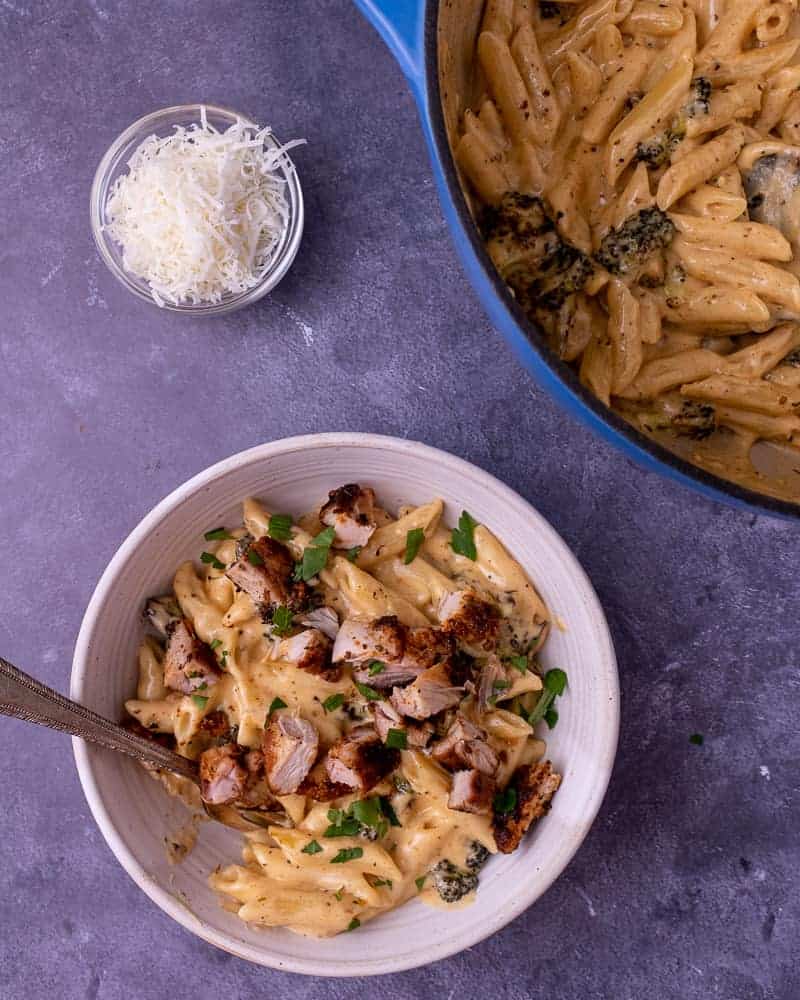
Tips and Tricks
What can you serve with this pasta dish? This is a very rich and comforting cheesy pasta. Definitely a treat to eat, it goes great with anything that lightens up the meal like a bitter greens side salad, which will cut through the richness of the pasta. If you’re my boyfriend, you always want it with garlic bread to soak up the sauce.
How do you store this pasta? This pasta has a cream based sauce, so in my experience it’s good the next day, but it’s best freshly mad. That doesn’t mean you can’t have leftovers though. Store this pasta in the fridge in an airtight container with an extra splash of either pasta water or heavy cream. You can store this dish in the fridge for up to three days.
How do you reheat this pasta? You should store your pasta leftovers with a splash or heavy cream, milk or leftover pasta water. When you reheat it in the microwave, reheat it slowly and be sure to stir it to avoid the sauce breaking or becoming clumpy. I’d recommend doing 30-45 seconds at a time and stirring just to make sure you don’t overheat the pasta and break the sauce. A broken sauce is still safe to eat but just may not have the best texture.
Method
How do you make cajun chicken pasta?
Roasting the Broccoli
Start by preheating the oven to 375 F and chopping the broccoli into bite sized florets. Toss lightly in olive oil and season with kosher salt to taste. Arrange in a single layer on a baking sheet and roast for 25-30 minutes until caramelized. For more detailed instructions check out this recipe.
Cooking the Cajun Chicken
While the broccoli is cooking, start cooking the cajun chicken. To start, pat dry the boneless skinless chicken thighs and season well with salt and cajun seasoning. In a 10-12 inch cast iron skillet, add just enough oil to coat the bottom of the pan. In a single layer, add in the chicken thighs flat side down and turn the heat to medium. Cook the chicken for eight to nine minutes undisturbed until it’s starting to brown. Flip each thigh and finish cooking for three to four minutes or until 170 F internally. Finally, let them rest for at least five minutes and then chop into bite sized pieces. Set aside.
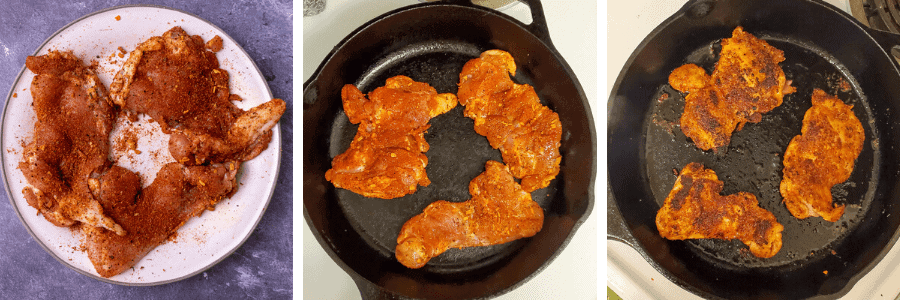
Cooking the Pasta
While the chicken is cooking, start your salted pasta water. Prep your other ingredients by grating the cheese, measuring out the flour, butter and heavy cream so that you can effortlessly bring the sauce together. Once the pasta water has begun boiling, pour in the pasta and stir immediately to prevent sticking. Set a timer for al dente pasta, following the directions on the pasta box.
Making the Sauce
In a dutch oven, melt the butter over medium heat until just beginning to foam but not brown. Quickly add the flour and whisk to form a roux; the mixture should be the consistency of wet sand. Continue to whisk the roux for one to two minutes, making sure to not burn the flour. Slowly, whisk in the heavy cream and continue to stir. Once that portion of heavy cream has been incorporated, slowly add the rest of the heavy cream, continuing to whisk the entire time until a creamy and smooth sauce has been formed. Reduce the heat to low and add one to two tablespoons of cajun seasoning to taste and whisk until mixed. Add half of the grated parmesan and mix until melted. Add the rest of the parmesan and mix well to form a smooth and creamy sauce. Season to taste with kosher salt and cajun seasoning.
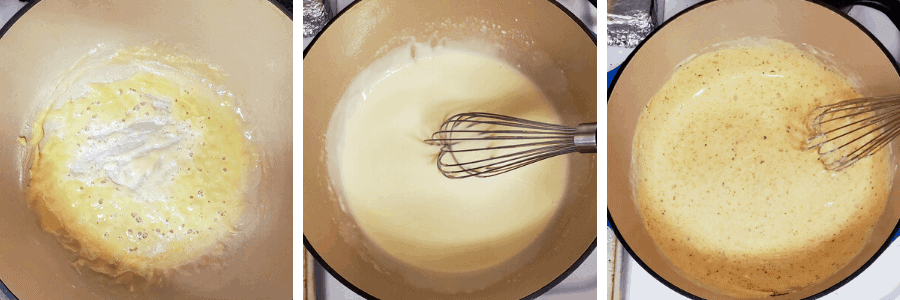
Assembly
Once the pasta is done, remove the pasta from the water with a slotted spoon or spider and place directly into the cajun alfredo sauce. Stir well to combine and if necessary, add ¼ cup of pasta water to loosen the sauce as needed. Add in the roasted broccoli and mix until coated in sauce. Portion out pasta into bowls and top with chopped cajun chicken. If desired, garnish with chopped parsley and enjoy immediately.

Why do you need to reserve your pasta water? Pasta water contains starch from the pasta and helps bind the sauce. It’s also a great way to loosen up your sauce a little bit if you use too much cheese or let it reduce too far. I always save a little just to make the sauce extra creamy.
How do you know the pasta is al dente? Almost always I just go by the suggestions on the back of the box of pasta as each brand is a little different and each type of noodle is a little different. To test it for yourself, carefully remove a piece of pasta from the water and let it cook briefly before biting into it. Pasta should have a little bit of a chew but not be crunchy. When you bite the noodle in half, there should be a small ring of uncooked pasta in the center.
Do you really need to salt your pasta water? Yes, I think that you should salt your pasta water. Unless you’re on a low sodium diet, salting your pasta water will give you more flavorful pasta, but you need to add enough salt. Don’t just add a few grains into a giant pot of water, but really salt it. It doesn’t matter if you salt it before or after it’s boiling, as it is a myth that it’ll change the time it takes the water to come to a boil (It will in large quantities but we’re not working with such large quantities that you’ll notice the difference). When I was learning to salt my pasta water, I would salt it before it was hot so I could taste it. I learned to do that after I very much over salted my pasta water (I only made the mistake once). If you do add too much salt, just add some more water to dilute it or start over.
Ingredients and Substitutions
What type of cajun seasoning do you use? I buy McCormick Gourmet Cajun seasoning at the grocery store. The bottle has a green top on a clear bottle. I’ve tried to use other cajun seasonings and they are often very salty. When choosing a cajun seasoning, enjoy the first ingredient is not salt.

What’s the best shape of pasta to use? I like to use penne or any pasta that has a small hole in it. This type of pasta will get the sauce inside the noodle, making each bite more flavorful. Another great type of pasta to use is rigatoni or anything with a large surface area for the same reason. The more surface area, the more flavorful sauce is on each noodle.
Do you have to use heavy cream? If you don’t have heavy cream you can substitute equal amounts of light cream or half and half. I wouldn’t use any type of milk, even whole milk because it’s just too watery. I’ve tried before and it’s pretty disappointing. If you’re looking to cut calories I recommend pairing a smaller portion of pasta with a bitter greens salad. That way you still get to enjoy the pasta but it isn’t so heavy.
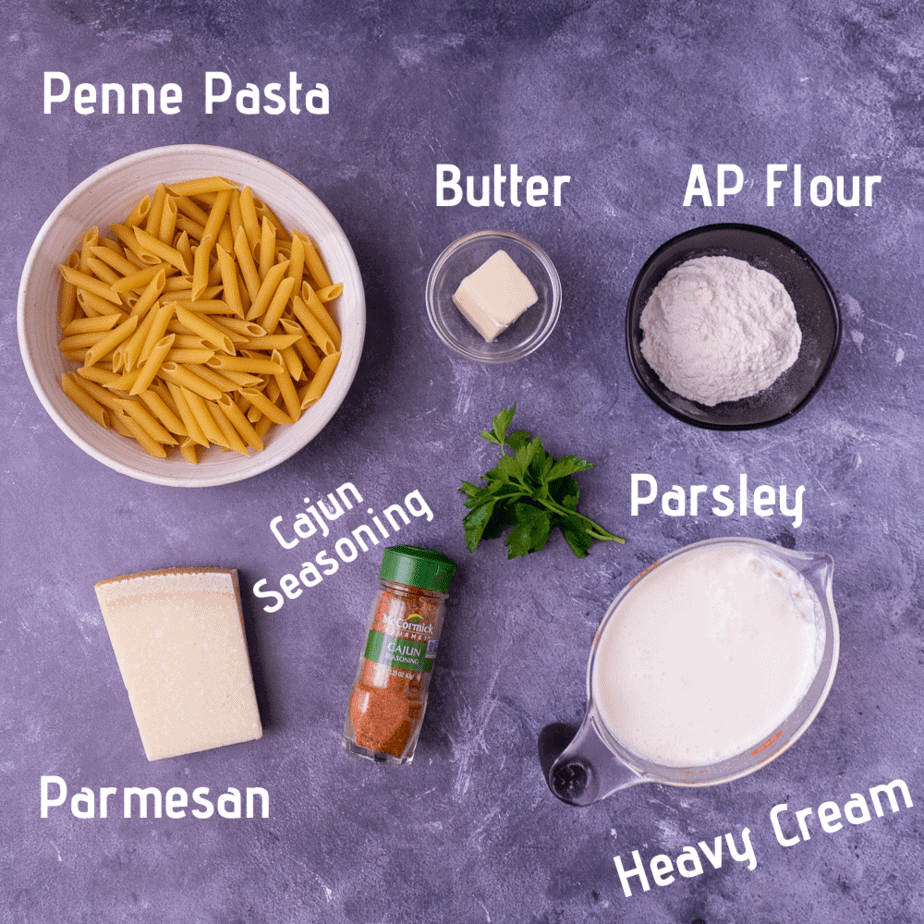
Should I buy pre-grated cheese, parmesan or Parmigiano-Reggiano? Ideally, in a perfect world, everyone would buy a block of Parmigiano-Reggiano and grate it themselves. However, it is expensive and can be tedious to grate a large amount of it. The reason it is expensive is because it is imported from a specific region in Italy, made in a specific way. Because of these regulations, you always know exactly the flavor you’re going to get and exactly how it’s going to melt, making it the ideal candidate for this recipe. If you can’t find the good stuff, domestic parmesan can work just as well, but sometimes the flavor can vary a little. It is made in the same style as the Italian import so be sure to grate it yourself! The pre-grated cheese that comes in a green can is a no go, just don’t do it. It is loaded with fillers and therefore won’t melt the same. The big draw of this dish is how rich and creamy the sauce is and pre-grated cheese just won’t do here.
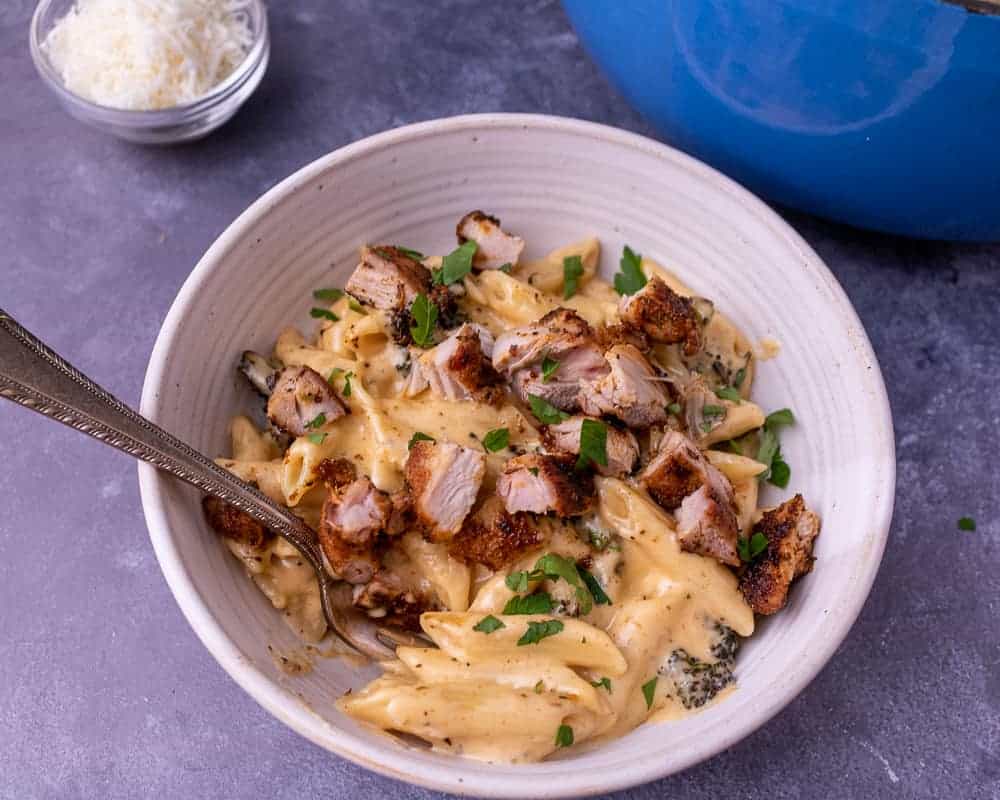
You May Also Like

Cajun Chicken and Broccoli Alfredo Pasta
Ingredients
- 1 large head of broccoli chopped
- Olive oil
- Kosher salt
- 3-4 boneless skinless chicken thighs
- 3-4 tablespoons cajun seasoning divided
- 8 oz penne pasta
- 3 tablespoons unsalted butter
- 3 tablespoons all purpose flour
- 2 cups heavy cream
- 1 ½ cup grated parmesan
- Fresh chopped parsley for garnish
Instructions
Roasting Broccoli
- Preheat the oven to 375F. Cut off the dried end of the broccoli stalk and discard. Remove florets with a knife and cut into 1-2 inch pieces. If desired, chop the stalk into ½ inch pieces. In a mixing bowl, add broccoli florets plus stalk, olive oil and salt to taste. Mix well until coated. Place broccoli in a single layer on a sheet pan and roast for 25-30 minutes until caramelized.
Cooking Cajun Chicken
- While the broccoli is cooking, start the cajun chicken. Pat dry the boneless skinless chicken thighs and season well with salt and cajun seasoning (about 2 tablespoons to well coat).
- In a 10-12 inch cast iron skillet, add just enough oil to coat the bottom of the pan. Next, add in the seasoned chicken thighs in a single layer, flat side down and turn the heat to medium.
- Allow the chicken to cook undisturbed for 8-9 minutes and then flip and finish cooking for 3-4 minutes (or until about 170 F internally).
- Once finished, set aside and allow to rest for at least 5 minutes and then chop into bite sized pieces.
Making Pasta and Sauce
- While the chicken is cooking, start your pasta water, making sure to salt the water.
- As the water is heating up, prep your other ingredients by grating the cheese, measuring out the flour, butter and heavy cream.
- Once the pasta water has begun boiling, pour in the pasta and stir immediately to prevent sticking. Set a timer for al dente pasta, following the directions on the pasta box, usually 8-11 minutes and stirring occasionally.
- In a 5-6 quart dutch oven or in a large pan, melt the butter over medium heat until just beginning to foam. Quickly add the flour and whisk to form a roux. The mixture should be the consistency of wet sand.
- Continue to whisk the roux for 1-2 minutes, making sure to not burn the flour.
- Slowly, whisk in the heavy cream and continue to stir. Start with about ¼ of a cup and whisk until mixed together, then add ¼ cup more heavy cream and continue to whisk. Finally, slowly add the rest of the heavy cream, continuing to whisk the entire time until a creamy and smooth sauce has been formed.
- Turn the heat down to low and add 1-2 tablespoons of cajun seasoning to taste. Whisk to combine.
- Add half of the grated parmesan and mix until melted. Add the rest of the parmesan and mix well to form a smooth and creamy sauce. Season to taste with kosher salt and cajun seasoning.
Assembly
- Once the pasta is done, remove the pasta from the water with a slotted spoon or spider and place directly into the cajun alfredo sauce. Stir well to combine, if necessary, add ¼ cup of pasta water to loosen the sauce.
- Stir in roasted broccoli until coated in sauce.
- Portion out pasta into bowls and top each bowl with chopped cajun chicken. If desired, garnish with chopped parsley and enjoy immediately.
Notes and Accommodations
- Don’t forget to reserve pasta water! I do this by using a spider to take the pasta out of the water instead of draining it directly. You can also save a small measuring cup worth before draining the pasta.
- If you’re worried about timing everything correctly, the broccoli and chicken can be cooked ahead of time and then you can start the pasta. The broccoli will be reheated in the pasta sauce and the chicken can be reheated briefly in the microwave or mixed into the pasta.
- If you’re planning on having leftovers, add either a little extra cream or leftover pasta water to leftovers and stir well after heating.
- It is important that you shred your own parmesan, the pre-grated cheese in a can will not melt properly and the sauce will be grainy.
- If you can, buy Parmigiano-Reggiano over domestic parmesan, it is worth the extra cost for the consistent flavor, salt amount and meltability.

